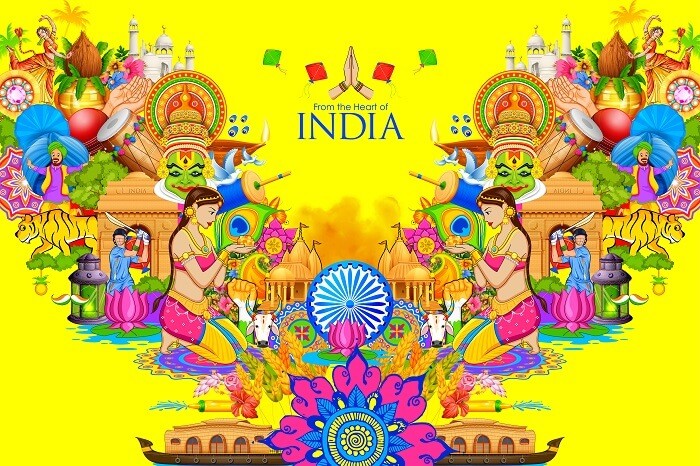“Embrace the vibrant tapestry of India’s rich cultural heritage.”
Cultural Kaleidoscope: Experiencing the Diversity of India is a captivating journey that allows individuals to immerse themselves in the rich and vibrant tapestry of Indian culture. From its diverse traditions, languages, religions, and cuisines to its breathtaking landscapes and architectural wonders, India offers a kaleidoscope of experiences that are sure to leave a lasting impression. This exploration of India’s cultural diversity provides a unique opportunity to appreciate and celebrate the country’s unique heritage and the multitude of influences that have shaped it over centuries.
Exploring the Rich Traditions and Festivals of India
India is a country known for its rich traditions and vibrant festivals. With a diverse population and a long history, India offers a kaleidoscope of cultural experiences that are truly unique. From the colorful celebrations of Diwali to the spiritual journey of Kumbh Mela, there is something for everyone to explore and enjoy.
One of the most widely celebrated festivals in India is Diwali, also known as the Festival of Lights. This five-day festival marks the victory of light over darkness and good over evil. During Diwali, homes are decorated with colorful lights and intricate rangoli designs. People exchange gifts and sweets, and fireworks light up the night sky. The festival is a time for families to come together and celebrate the triumph of good over evil.
Another festival that showcases the diversity of India is Holi, the Festival of Colors. Holi is a joyous celebration of the arrival of spring. People gather in the streets and throw colored powders and water at each other, creating a vibrant and playful atmosphere. Holi is a time to let go of inhibitions and embrace the spirit of fun and togetherness.
For those seeking a spiritual experience, the Kumbh Mela is an event not to be missed. Held every twelve years, the Kumbh Mela is the largest gathering of people on earth. Millions of pilgrims from all over India and beyond come together to bathe in the holy rivers, seeking spiritual purification. The Kumbh Mela is a testament to the deep-rooted faith and devotion of the Indian people.
India is also home to a wide variety of traditional dances and music. From the classical dance forms of Bharatanatyam and Kathak to the energetic folk dances of Bhangra and Garba, there is a dance style to suit every taste. These dances are not only a form of entertainment but also a way to preserve and pass on the rich cultural heritage of India.
In addition to festivals and dances, India is known for its traditional arts and crafts. From intricate embroidery and pottery to colorful textiles and jewelry, Indian artisans have been honing their skills for centuries. These crafts not only showcase the creativity and craftsmanship of the Indian people but also provide livelihoods for many communities.
Exploring the rich traditions and festivals of India is a journey that will leave you with a deeper appreciation for the country’s cultural diversity. Whether you are witnessing the grandeur of the Kumbh Mela or immersing yourself in the colors of Holi, each experience will be a feast for the senses. The vibrant celebrations, the intricate dances, and the exquisite crafts all come together to create a tapestry of cultural experiences that is truly unforgettable.
In conclusion, India’s rich traditions and festivals offer a glimpse into the country’s diverse cultural heritage. From the joyous celebrations of Diwali and Holi to the spiritual journey of the Kumbh Mela, there is something for everyone to explore and enjoy. The traditional dances, arts, and crafts further add to the cultural kaleidoscope that is India. So, pack your bags and get ready to embark on a journey of a lifetime as you experience the diversity of India firsthand.
Unveiling the Architectural Marvels: A Journey through India’s Heritage Sites
India is a country known for its rich cultural heritage and diverse architectural marvels. From ancient temples to majestic palaces, India’s heritage sites offer a glimpse into the country’s glorious past. Embarking on a journey through these sites is like stepping into a time machine, where one can witness the architectural brilliance of different eras.
One of the most iconic heritage sites in India is the Taj Mahal, located in Agra. Built by Emperor Shah Jahan in the 17th century, this white marble mausoleum is a symbol of eternal love. Its intricate carvings and delicate inlay work leave visitors in awe of the craftsmanship of that era. As the sun sets, the Taj Mahal’s pristine white facade changes color, creating a mesmerizing sight that is truly unforgettable.
Moving on from Agra, a visit to Rajasthan takes us to the majestic forts and palaces that dot the landscape. The Amber Fort in Jaipur is a prime example of Rajput architecture. Perched on a hilltop, this fort offers panoramic views of the surrounding landscape. Its ornate halls, intricate frescoes, and mirror work transport visitors to a bygone era of opulence and grandeur.
Another architectural gem in Rajasthan is the City Palace in Udaipur. This sprawling complex is a blend of Rajput and Mughal architectural styles. With its intricate balconies, courtyards, and gardens, the City Palace is a testament to the artistic sensibilities of the rulers of Mewar. A boat ride on Lake Pichola, with the palace as a backdrop, adds to the magical experience.
Moving south, the state of Tamil Nadu is home to some of the most magnificent temples in India. The Brihadeeswarar Temple in Thanjavur is a UNESCO World Heritage Site and a masterpiece of Dravidian architecture. Its towering vimana (temple tower) and intricate sculptures leave visitors in awe of the skill and devotion that went into its construction. The Meenakshi Amman Temple in Madurai is another architectural marvel, with its colorful gopurams (gateway towers) and intricate carvings depicting mythological stories.
Venturing further east, the state of Odisha is home to the famous Konark Sun Temple. Built in the 13th century, this temple is dedicated to the Sun God and is a UNESCO World Heritage Site. Its intricate stone carvings, depicting various aspects of life and mythology, are a testament to the artistic prowess of the craftsmen of that era. The temple’s unique chariot-like structure is a sight to behold.
As one travels through India’s heritage sites, it becomes evident that each region has its own unique architectural style and cultural influences. From the intricate carvings of North India to the towering gopurams of South India, the diversity of architectural styles is a reflection of India’s rich history and cultural heritage.
Visiting these heritage sites not only offers a visual treat but also provides an opportunity to delve into the history and culture of India. It is a journey that takes us back in time, allowing us to appreciate the architectural brilliance of our ancestors. Whether it is the serene beauty of the Taj Mahal or the grandeur of Rajasthan’s forts and palaces, each site has its own story to tell.
In conclusion, India’s heritage sites are a treasure trove of architectural marvels that showcase the country’s rich cultural heritage. From the iconic Taj Mahal to the majestic forts and palaces of Rajasthan, each site offers a unique experience. Exploring these sites is like unraveling the layers of India’s history, and it is a journey that should not be missed by anyone seeking to experience the diversity and grandeur of this incredible country.
Tasting the Flavors of India: A Culinary Adventure through Regional Cuisine
India is a country known for its rich cultural heritage and diversity. From its languages and religions to its art and architecture, India is a melting pot of different traditions and customs. One of the best ways to experience this diversity is through its cuisine. Indian food is as diverse as its people, with each region having its own unique flavors and cooking techniques. Embarking on a culinary adventure through regional cuisine is a delightful way to explore the cultural kaleidoscope of India.
In the northern region of India, one can savor the rich and aromatic flavors of Mughlai cuisine. Influenced by the Mughal Empire, this cuisine is characterized by the use of rich spices and slow cooking techniques. Popular dishes include biryani, kebabs, and butter chicken. The use of ingredients like saffron, cardamom, and ghee adds a distinct flavor to the dishes. The cuisine of Punjab, another northern state, is known for its hearty and robust flavors. Dal makhani, butter naan, and sarson ka saag are some of the must-try dishes from this region.
Moving towards the western part of India, one encounters the vibrant and spicy flavors of Gujarati cuisine. Known for its vegetarian dishes, Gujarati cuisine is a perfect blend of sweet, sour, and spicy flavors. Dhokla, khandvi, and thepla are some of the popular dishes that showcase the unique taste of this region. Maharashtra, another western state, offers a diverse range of flavors. From the street food of Mumbai, such as vada pav and pav bhaji, to the traditional Maharashtrian thali, which includes dishes like puran poli and batata vada, the cuisine of Maharashtra is a true reflection of its cultural diversity.
As one travels towards the southern part of India, the flavors become more complex and diverse. The cuisine of Tamil Nadu is known for its use of spices and coconut. Dishes like dosa, idli, and sambar are staples in this region. Kerala, on the other hand, is famous for its seafood delicacies. The use of coconut oil and coconut milk gives a unique flavor to dishes like fish curry and appam. Andhra Pradesh, known for its spicy cuisine, offers dishes like biryani, gongura pachadi, and mirchi bajji that are sure to tantalize the taste buds.
In the eastern part of India, one can experience the flavors of Bengal. Bengali cuisine is known for its subtle and delicate flavors. Fish plays a prominent role in this cuisine, with dishes like macher jhol and shorshe ilish being popular choices. The use of mustard oil and panch phoron, a blend of five spices, adds a distinct taste to the dishes. Moving towards the northeastern states, one encounters a completely different culinary experience. The cuisine of Assam, Manipur, and Nagaland is characterized by the use of bamboo shoots, fermented fish, and local herbs. Dishes like masor tenga, eromba, and smoked pork showcase the unique flavors of this region.
Embarking on a culinary adventure through regional cuisine in India is not just about tasting different flavors; it is about immersing oneself in the rich cultural heritage of the country. Each dish tells a story, reflecting the history, traditions, and customs of the region it comes from. From the rich and aromatic flavors of the north to the spicy and vibrant tastes of the south, India’s regional cuisine is a true reflection of its diverse and colorful culture. So, grab a plate and embark on a journey through the flavors of India.In conclusion, Cultural Kaleidoscope: Experiencing the Diversity of India offers a unique opportunity to explore and appreciate the rich cultural heritage of India. Through its diverse traditions, languages, cuisines, and art forms, the country showcases a vibrant tapestry of diversity. By immersing oneself in this kaleidoscope of cultures, one can gain a deeper understanding and appreciation for the unique identities that make up India’s cultural landscape. Whether it is through attending festivals, visiting historical sites, or engaging with local communities, Cultural Kaleidoscope provides a transformative experience that celebrates the beauty and diversity of India.


